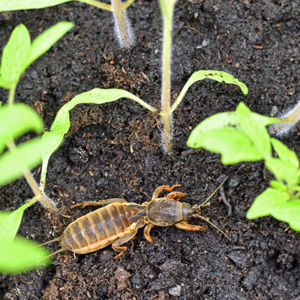Invasive mole crickets are a serious problem for many Pensacola homeowners. These unearthly-looking creatures seem like they came from outer space. Unfortunately, the damage they cause to your lawn also feels out of this world.
Keep reading to learn everything about mole crickets, how to identify signs of mole cricket damage, and how to effectively control these pests.
Types of Mole Crickets
In Florida, there are four species of mole crickets. Three of them are invasive pests: the tawny mole cricket, southern mole cricket, and short-winged mole cricket. The fourth species, the northern mole cricket, is native to the state and not considered a pest.
How to Identify a Mole Cricket
Mole crickets have a distinct appearance, but they are hard to spot. These pests tunnel deep underground and emerge only at night. Mole crickets resemble a cross between a cricket and a lobster, measuring about 1 to 2 inches long. They have gray-brown bodies with a velvety texture and large, clawed front legs designed for digging.
The Life Cycle of The Mole Cricket
Mole crickets undergo several life stages: egg, nymph, and adult. In spring, they become adults just in time for the mating season. Male mole crickets build mating chambers at the tunnel surface, singing to attract females. After mating, the male dies, and the female burrows up to 10 inches to lay her eggs.
Why Are Mole Crickets Harmful to Your Lawn?
These pests feed on the roots of Pensacola’s warm-season grasses, including bahiagrass, bermudagrass, St. Augustinegrass, centipedegrass, and zoysia.
The primary damage comes from their tunneling near the soil surface, which loosens the topsoil and uproots plants. As a result, the grass dries out and dies, leading to brown patches often overtaken by weeds.
Common Signs of Mole Cricket Damage:
-
Small mounds of dirt scattered on the surface
-
Raised soil and spongy grass
-
Brown, dry, or dead patches of grass
How to Check For Mole Crickets
Since mole cricket damage can mimic other lawn issues, it’s essential to confirm their presence. To do this, mix 1.5 ounces of liquid dishwashing soap with 2 gallons of water. In the morning or evening, pour this mixture over a 1 to 2 square foot area. If mole crickets emerge, you know you have a problem.
When Are Mole Crickets Most Active in Pensacola
Mole crickets are most destructive between March and June and from late August through October. They are nocturnal, spending the day underground and emerging at night to feed, tunnel, and fly. Due to their nocturnal habits, damage is often discovered too late.
Mole Cricket Prevention Tips
Mole crickets can damage any turfgrass species, but they especially favor Bahia grass and bermudagrass. They are drawn to lawns with excessive thatch, a layer of grass clippings, organic matter, and debris on the soil’s surface.
Tips to Prevent Mole Cricket Infestations:
- Proper Mowing: Maintain a healthy lawn height.
- Regular Irrigation: Keep your grass hydrated without overwatering.
- Annual Aeration: Reduce thatch to minimize mole cricket habitats.
- Fertilization: Strengthen your lawn to withstand infestations.
If your Pensacola lawn is already damaged by mole crickets, seek professional lawn care services for effective mole cricket control.
Stop Mole Crickets With Insect and Pest Control From Lawn Master
Lawn Master understands the different types of grass and pests that live on Pensacola’s residential and commercial lawns. We provide an insect and pest control service to help keep your yard insect and pest-free. As part of our insect and pest management service, we include a free lawn evaluation. This allows our trained and knowledgeable technicians to determine the specific types of pests damaging your lawn. We will then devise a plan of action. We offer insect and pest control year-round, and it can be purchased separately.
Learn more about our insect and pest control by contacting us online or giving us a call at 850-476-1601.
While here, learn more about our lawn care program designed to keep your lawn healthy and strong, as well as our aeration services designed to keep thatch from suffocating your lawn. Call us today.
For more tips and ideas like the article above, visit and follow our monthly blogs.